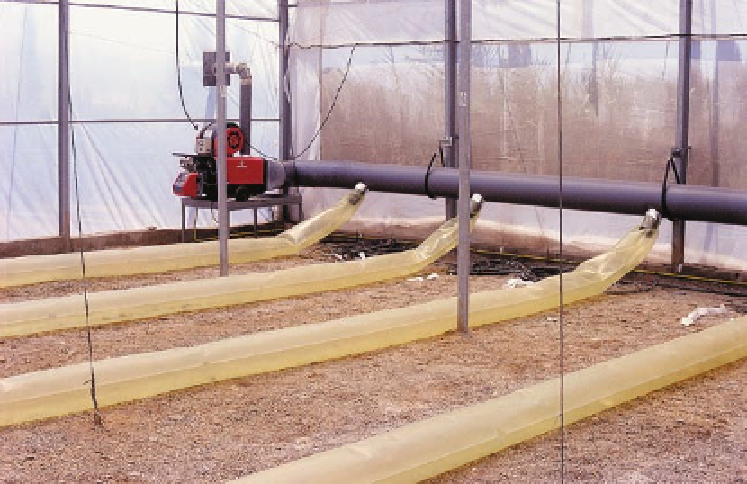Agriculture Reference
In-Depth Information
Indirect combustion hot air genera-
tors expel the combustion gases to the
exterior. The heat distribution improves
notably if the hot air is delivered through
perforated flexible plastic pipes (located
over the floor to avoid shadows) (Photo
7.3). It is recommended that tubes are
designed that allow a flow from a third to
a fourth of the volume of the greenhouse
min
−1
, with an air velocity at the start of
the tube of 5-6 m s
−1
. The total perforated
area in the pipe must be, in total, from 150
to 200% of the section of the tube (ASAE,
2002). The length of the tube must not sur-
pass 50 m; it being preferable to limit it to
30 m. The plant temperature is usually
lower than the air, which involves the risk
of water condensing on the plant surfaces
and, as radiation heat is not supplied, the
soil is not heated during the cold season
(Bordes, 1992).
Heat pumps absorb heat from a cold to
warm source (water or external air) and
blow it inside the greenhouse (see section
7.4.4), but they are not very common.
Convective heating systems are not effi-
cient. Besides, the warm air weighs less
than the cold air and tends to rise, away
from the plants. There may be temperature
differences between the base and the top of
the plants of 2-3°C (Urban, 1997a). The
advantage is that the convective systems are
cheap to install and respond quickly, but
they have low thermal inertia. Their use is
common in low-cost greenhouses, as a
defence mechanism against very low tem-
peratures. In this case, the set point temper-
ature is usually maintained at around 5-7°C,
to start running the system under extremely
cool conditions (Urban, 1997a).
7.4.2
Radiative-convective heating
Hot water
In classic radiative heating systems using
hot water at high temperature, the heating
element is a tube or radiating surface which
dissipates the heat by radiation and con-
vection with the air (Bordes, 1992). Heat
transmission by conduction only takes
place inside the tube. The plant surface
temperature is higher than that of the sur-
rounding air, which limits water condensa-
tion over the plants and its influence in the
development of diseases. These systems are
more expensive than convective ones, but
are more efficient and have higher thermal
inertia.
Photo 7.3.
Indirect combustion hot air generator and flexible plastic air distribution pipes.

